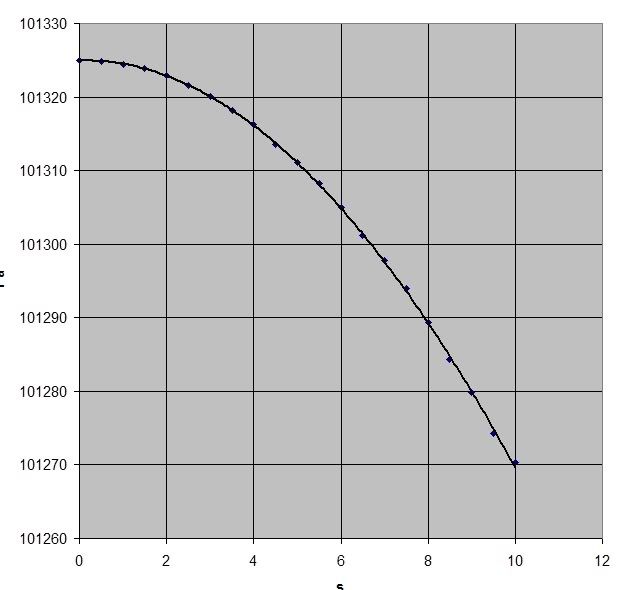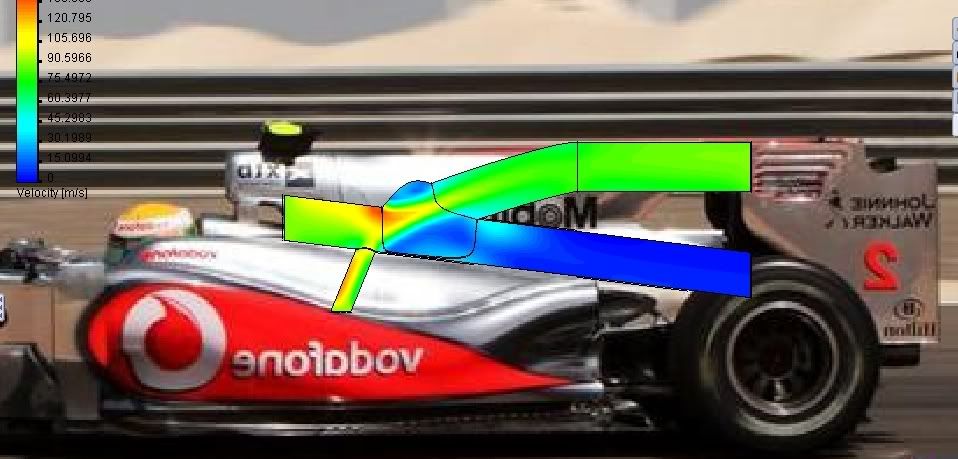Here is the video folks, first time using the program to create flow trajectory vidoe so bear with me.
Blue is low pressure , red is high, everything else is in between.
[youtube]
http://www.youtube.com/watch?v=L7eG2TosLY8[/youtube]
The lower pipe is over the bridge wing and the upper pipe leads to the wing slit. Small, almost vertical pipe is supposed to be from the snorkel.
What is happening here is that the snorkel pipe is not activated at all, ie there is no air being supplied to the fin chamber from the snorkel.
If you look closely the air coming in from the intake, is evenly dispersed between the lower and upper pipe at low speeds where the pressures are about the same.
As speed increases things change though.
Both outlets create suction. The underside of the rear wing draws more vacuum than the covered pipe over the bridge wing.
And if some find it confusing that I said suction on top the bridge wing, which should be high pressure, i am referring to the little shroud over the pipe. Air passing by the sides of this shroud will pull on the flow in the pipe causing low pressure.
Here is the shroud over the pipe atop the bridge wing (it has a little flow vis in it) just so you know what i am talking about.

So with that we have 2 outlets pulling vacuum. As speed increases the pressure drops more. The pressure drops at different rates over the outlets. The flow in the fin chamber will deviate to the outlet that has the faster rate of drop and has the lowest pressure over all.
This can happen without the help of the snorkel air to direct the flow.
In the video the car is accelerating for 3 seconds, though i tested it up to 10. I used accel of 11.1 m/s^2 and mapped the pressure vs time drop under the wing i built, in another model earlier, and also over it's bridge wing, with a little shroud in the middle part. Knowing this i can map the end conditions on the outlets and inlets.
pressure drop of shrouded pipe:

The rear wing suction is way more than the shrouded outlet pipe. rear wing in pink, shroud in blue:

Obviously a time will come where the wing suction so great the flow will take the easier rout with the least resistance. The flow will go to the slot naturally, no help needed from a snorkel. This can be seen in the video, where the lower pipe flow begins to get red, this is relative to the suction pressure of the wing slot and the flow is clearly diverting upwards.
What i find surprising is that it sucks so much, it is pulling air from the lower outlet pipe backwards. At least that is what i am seeing, i don't know what to deduce from that though.
What I also took not of is that the fin slot begins blowing at 1.8s!, the car is barely up to speed, it's going to need the down-force at such speeds. This is where i think the tuning of the pipes come in. It could be mclaren made them in such a way that the flow deviates not at the low speeds mine does, but at a much higher speed (captain obvious).
This is done by restricting the fin slot to a smaller area, or flaring the shrouded pipe. They can also use the snorkel air to influence what and when things happen in the fin chamber.
It can blow to push the air in any which way. Maybe up like mines, or downward, which ever suits how their chamber actually looks and operates.
So with that i'd say the system is both passive and reactive, ie if the snorkel is for real. But the system can operate passively.
I will now turn on the snorkel and see what kind of influence it can have, maybe it forces the diversion earlier. Or it can be remodeled to delay the diversion. The pipe diameters can also be changed, an orifice restrictor or venturis could be added; so many variables.
Any criticisms let me know, i could have overlooked something.












